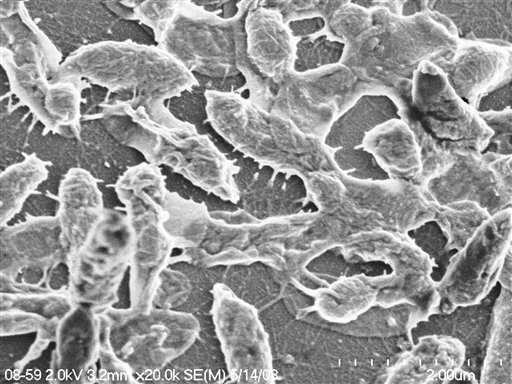COLUMBIA, S.C. — Days after giving birth to twins, a South Carolina mother has been hospitalized for what doctors say is a rare flesh-eating infection.
The development follows the similar affliction of a Georgia graduate student, who lost her left leg and may lose her fingers. But experts say the South Carolina case, though serious, is less severe than the Georgia one and caused by a different bacterium.
Lana Kuykendall, 36, gave birth to healthy twins at an Atlanta hospital last week. When the new family of four returned to their home in Piedmont, the mother — who is also a paramedic — noticed a pain and rash on her left leg.
As the spot began to spread, Kuykendall went to a local hospital, where she has since undergone several surgeries but was improving today.
“She’s stable,” Darren Kuykendall, the woman’s husband, told The Associated Press in a phone interview from Greenville Memorial Hospital.
Friends and family are helping care for the couple’s week-old twins, who are healthy. A fund has been set up to help with Kuykendall’s care.
The condition is called necrotizing fasciitis, the same disorder that has Georgia graduate student Aimee Copeland fighting for her life in a hospital several hundred miles away. Doctors say Copeland, 24, has lost a leg and could lose all her fingers from the infection that spread days after she suffered a deep cut while zip-lining.
In that case, doctors have said Copeland has been infected by Aeromonas hydrophila, a flesh-eating bacterium that emits toxins that cut off blood flow to parts of the body, destroying muscle, fat and skin tissue. Flesh-eating Aeromonas cases are so rare that only a handful of infections have been reported in medical journals in recent decades.
Dr. William Schaffner, an infectious disease expert at Vanderbilt University Medical Center, said the South Carolina woman’s case has its root in Group A streptococcus. That’s the same bacteria that can cause strep throat, of which millions of cases are reported annually in the U.S., according to the Centers for Disease Control and Prevention.
But when it finds an area of the body that has recently undergone a trauma — like a cut or deep bruise, which Kuykendall may have experienced during the delivery of her twins — Group A strep can manifest itself into the flesh-eating disorder that has landed Kuykendall in the hospital, Schaffner said.
“It causes a lot of pain,” Schaffner said. “It can evade diagnosis for a period of time.”
According to the CDC, between 9,000 and 11,500 cases of invasive Group A strep happen each year in the United States, resulting in upward of 1,000 deaths.
Not contagious, the bacterium is best treated by antibiotics and surgeries to remove dead tissue, which Schaffner said can spread so rapidly that doctors must go in multiple times to cut out more areas.
Kuykendall, who has been keeping vigil at the hospital, said he knows his wife will improve but is sad she has missed time bonding with their babies.
“The sad part about it is that she hasn’t gotten to see the babies for the first week of their lives,” Kuykendall told WYFF-TV (http://bit.ly/KBkzMd). “I talk to her every day. I tell her how good she’s doing, and how strong she is, and that she’s a fighter. She can make it.”
Send questions/comments to the editors.



Success. Please wait for the page to reload. If the page does not reload within 5 seconds, please refresh the page.
Enter your email and password to access comments.
Hi, to comment on stories you must . This profile is in addition to your subscription and website login.
Already have a commenting profile? .
Invalid username/password.
Please check your email to confirm and complete your registration.
Only subscribers are eligible to post comments. Please subscribe or login first for digital access. Here’s why.
Use the form below to reset your password. When you've submitted your account email, we will send an email with a reset code.